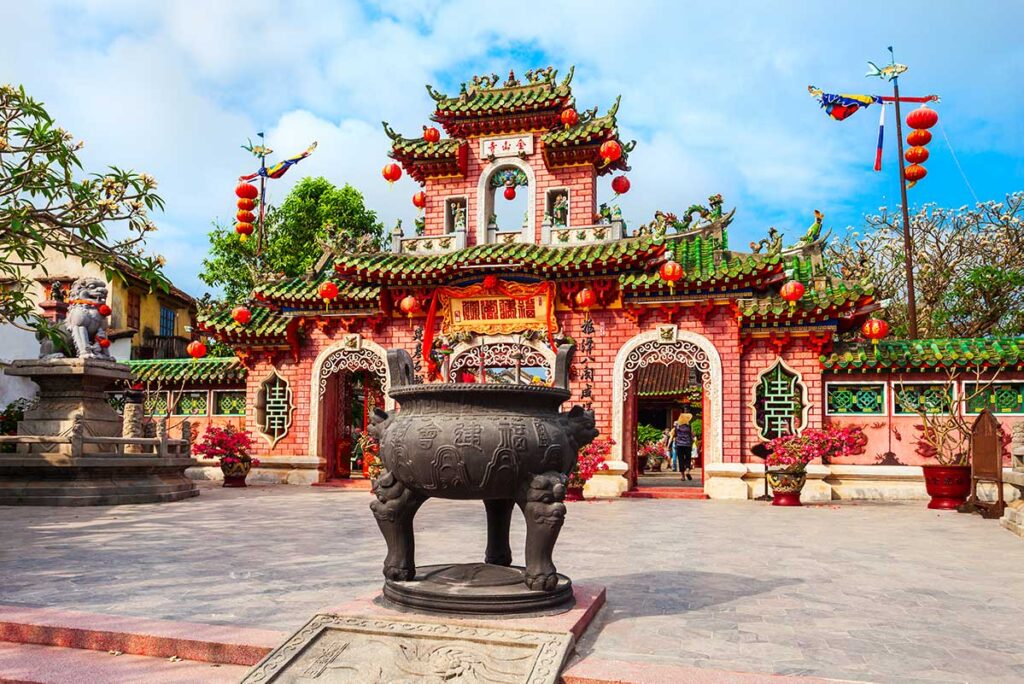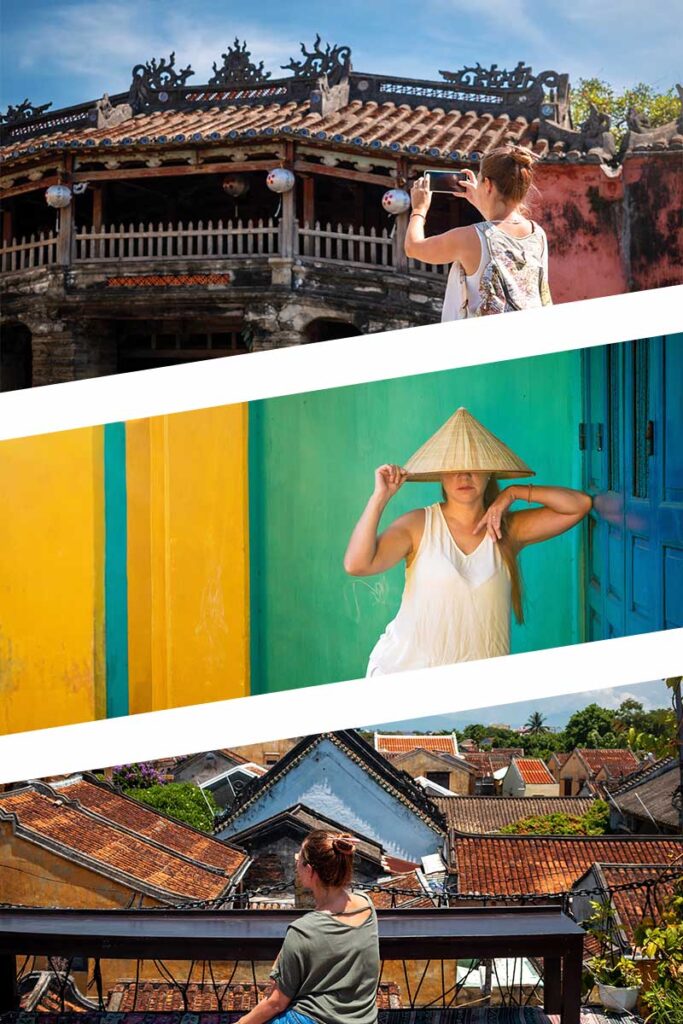What is the Fujian Assembly Hall?
The Fujian Assembly Hall, also known as the Phuc Kien Assembly Hall, is a historic meeting hall built by Chinese immigrants from Fujian Province. Originally a place for community gatherings, it became a religious and cultural center where the Fujianese community in Hoi An worshipped their guardian deity, Mazu (also known as Thiên Hậu), the sea goddess who protects sailors and merchants on their journeys.
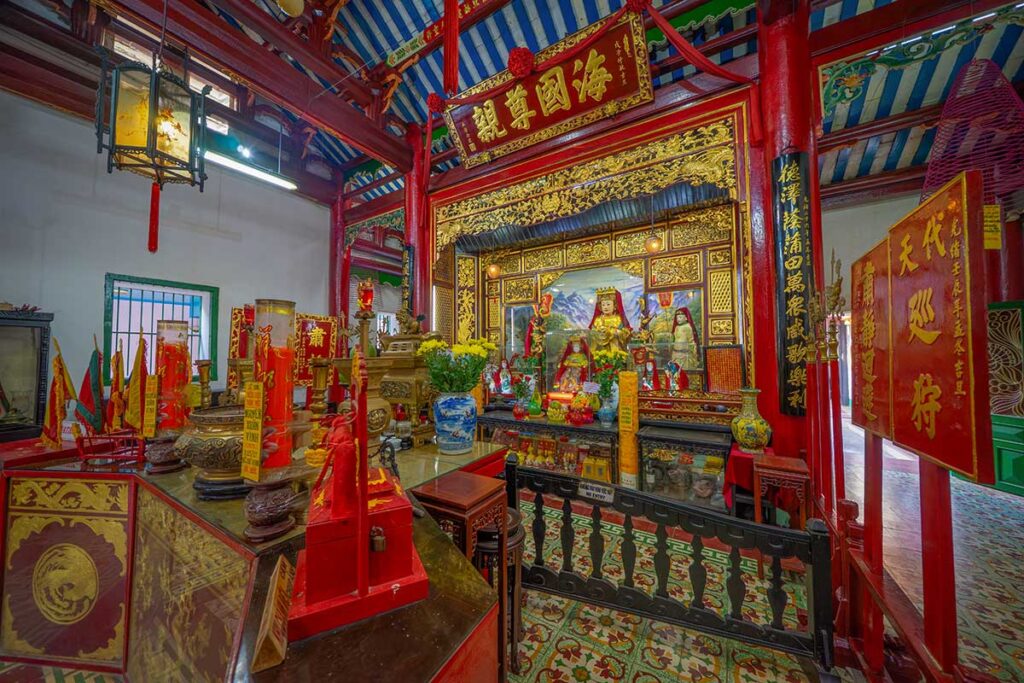
This is the largest and most famous of all the Chinese assembly halls in Hoi An, known for its grand architecture and central location on Tran Phu Street. Assembly halls like this one were common among Chinese merchant communities, serving both spiritual and communal purposes. Hoi An is home to several others, including the Cantonese, Hai Nam, Teochew, and Chinese (Ngu Bang) Assembly Halls — each tied to a different regional Chinese group.
The Fujian Assembly Hall stands out not only for its size and ornate design, but also for its deep spiritual meaning, vibrant festivals, and importance in preserving Hoi An’s multicultural heritage.
Hoi An Walking Tour by Local Guide
- Experience Explore Hoi An’s Ancient Town with an expert local guide and insider stories.
- Includes Market visit, traditional house, colorful temples, and coffee break by electric car.
History of the Fujian Assembly Hall
The Fujian Assembly Hall (Phuc Kien) traces its origins to the late 1600s, when Fujianese merchants settled in Hoi An during its peak as a bustling port. In 1692, local residents built a small temple called Kim Son Pagoda, dedicated to Mazu (Thiên Hậu), the sea goddess revered by coastal traders for her protection during long voyages.
According to local legend, a statue of Mazu was discovered drifting near the coast of Hoi An in 1697, reinforcing her spiritual presence and deepening the community’s devotion. In 1757, the growing Fujian community took over the site, rebuilt it into a grand assembly hall, and renamed it the Phuc Kien Assembly Hall.
Over the centuries, the hall underwent several renovations, reflecting its continued role as both a religious sanctuary and a community hub. It became the largest and most prominent Chinese assembly hall in Hoi An, central to many traditional ceremonies and festivals.
Today, it stands as a well-preserved heritage site, attracting visitors with its rich cultural history, symbolic architecture, and spiritual atmosphere.
Highlights & Architecture
The Fujian Assembly Hall (Phuc Kien) is the most elaborate of Hoi An’s Chinese halls. Its bold colors, intricate carvings, and symbolic layout reflect traditional Chinese beliefs in harmony, prosperity, and protection — especially for merchants and seafarers. The structure follows a classic layout, leading you through gates, courtyards, and worship halls in a meaningful, spiritual flow.
1. Tam Quan Gate (Three-Arch Gate)

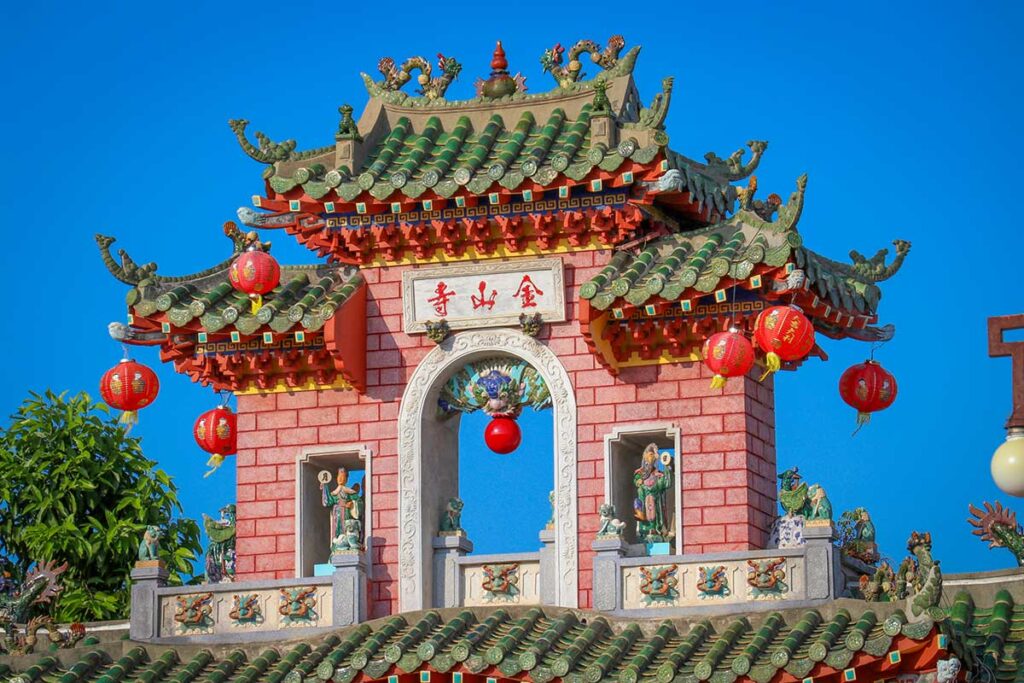
The striking entrance gate features three arched doorways, symbolizing Heaven, Earth, and Humanity. In line with traditional feng shui, the side doors are for everyday use, while the central arch — often kept closed — is reserved for deities and special rituals. The gate is topped with mythical creatures, including dragons and phoenixes, and decorated with colorful porcelain tiles that set the tone for what’s inside.
2. Courtyard & Garden
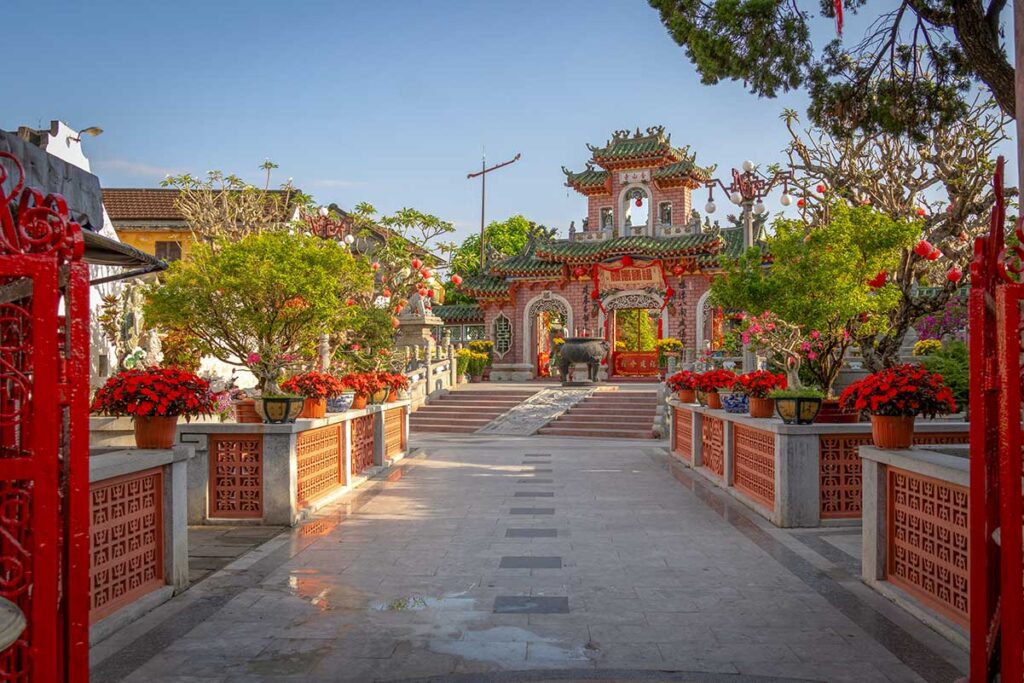
Past the gate, a peaceful courtyard features miniature landscapes, statues, and bonsai trees. A small fish pond, ornamental plants, and stone paths guide you toward the main hall. It’s a scenic and shaded space that offers a quiet break from the busy streets outside.
3. Main Hall & Deity Statues

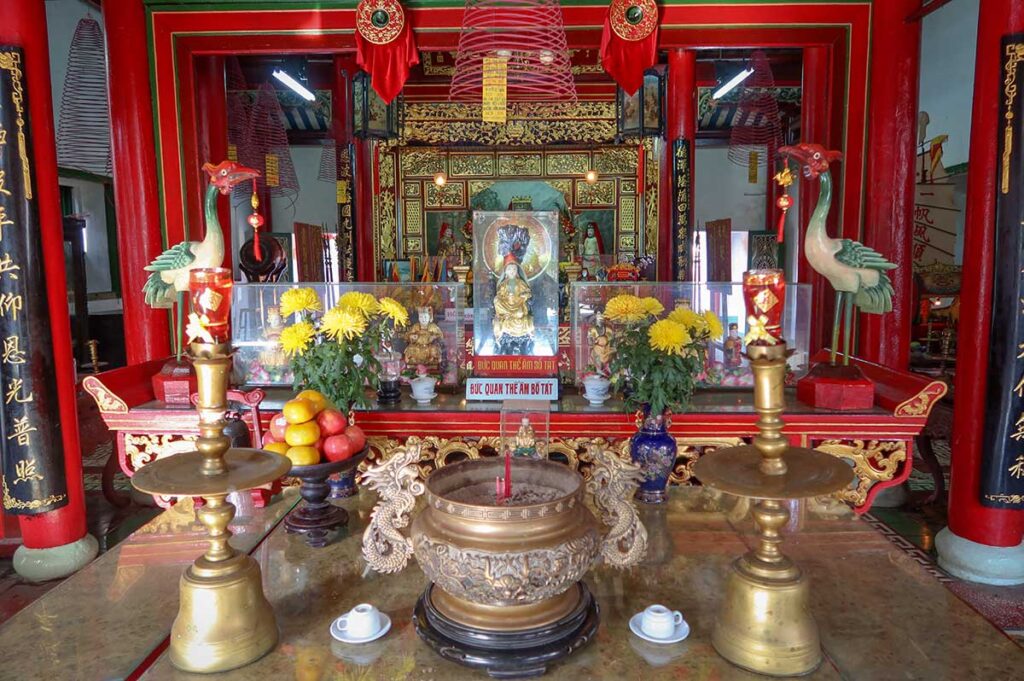
At the heart of the hall is the altar of Thien Hau (Mazu), the revered sea goddess. She’s flanked by her divine guardians: Thien Ly Nhan (Eyes That See a Thousand Miles) and Thuan Phong Nhi (Ears That Hear the Wind). The shrine is often filled with burning incense coils, offerings, and candles. Visitors come here to pray for safe travel, good fortune, and spiritual guidance.
4. Side Halls & Displays
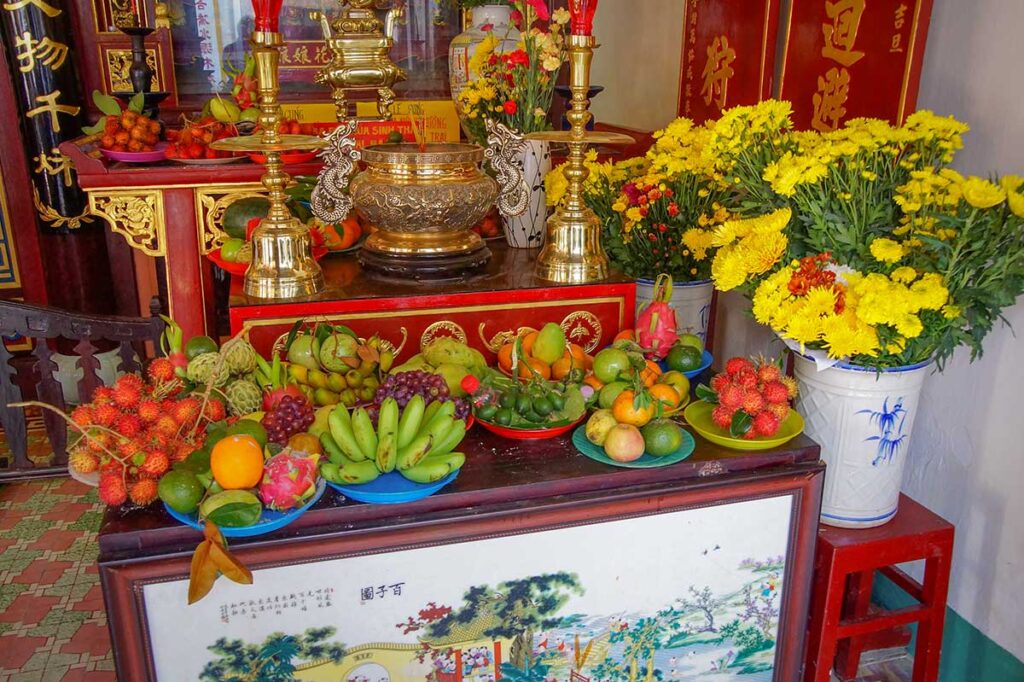
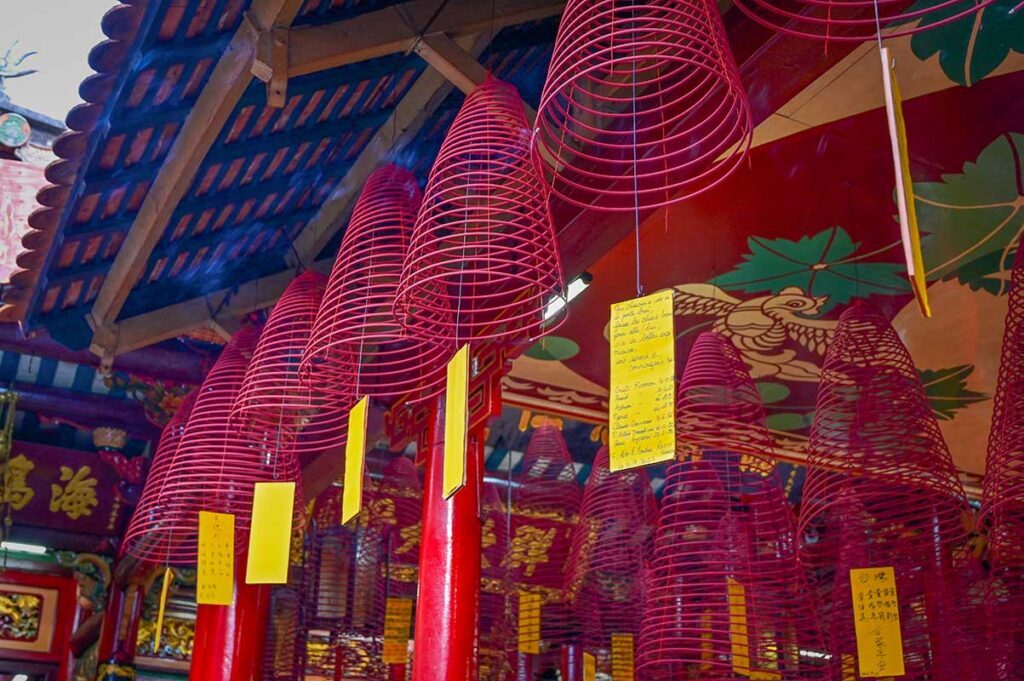
The east and west wings include altars to other deities, including the Goddess of Fertility, the God of Wealth, and ancestral figures.
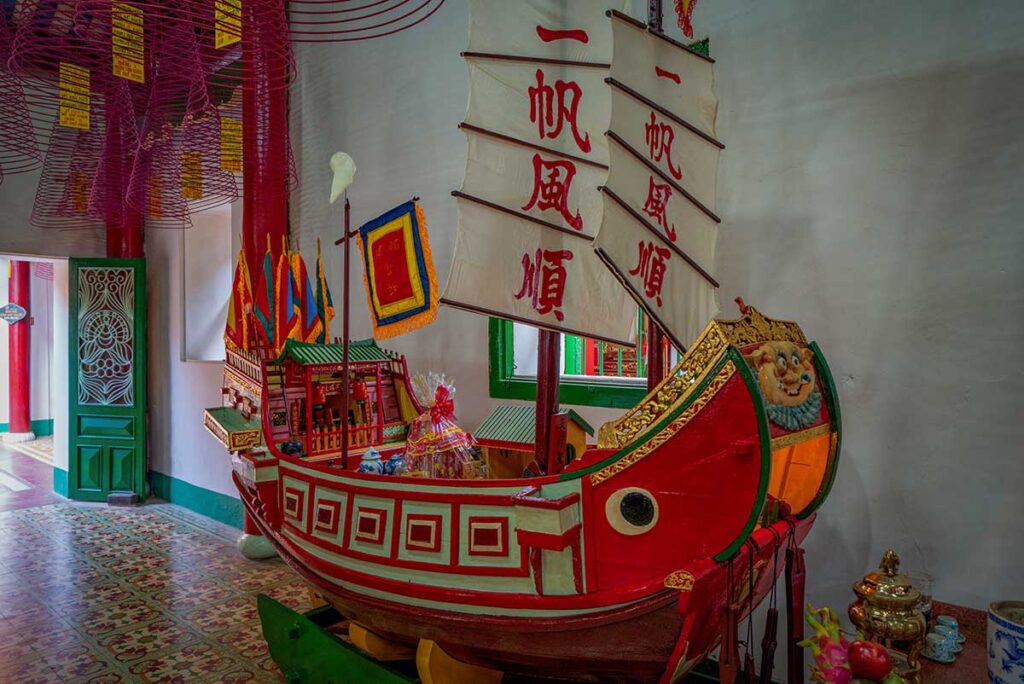
You’ll also find historical relics like bronze bells, a wooden model of a merchant ship, and calligraphy panels that highlight the cultural role of the hall in the community.
5. Carvings, Mosaics & Symbolism
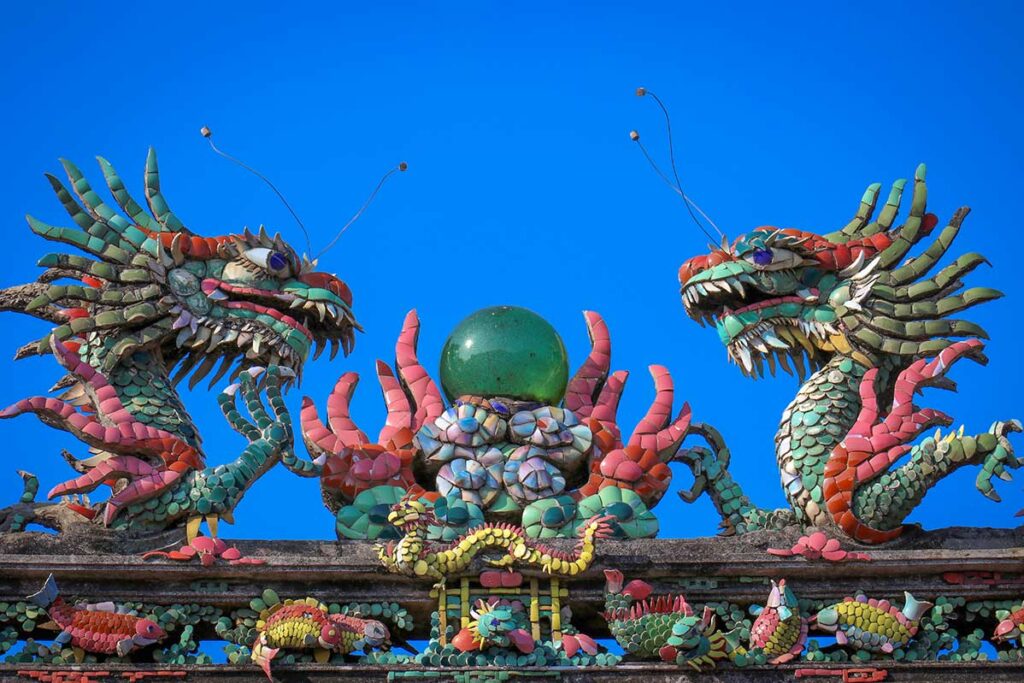
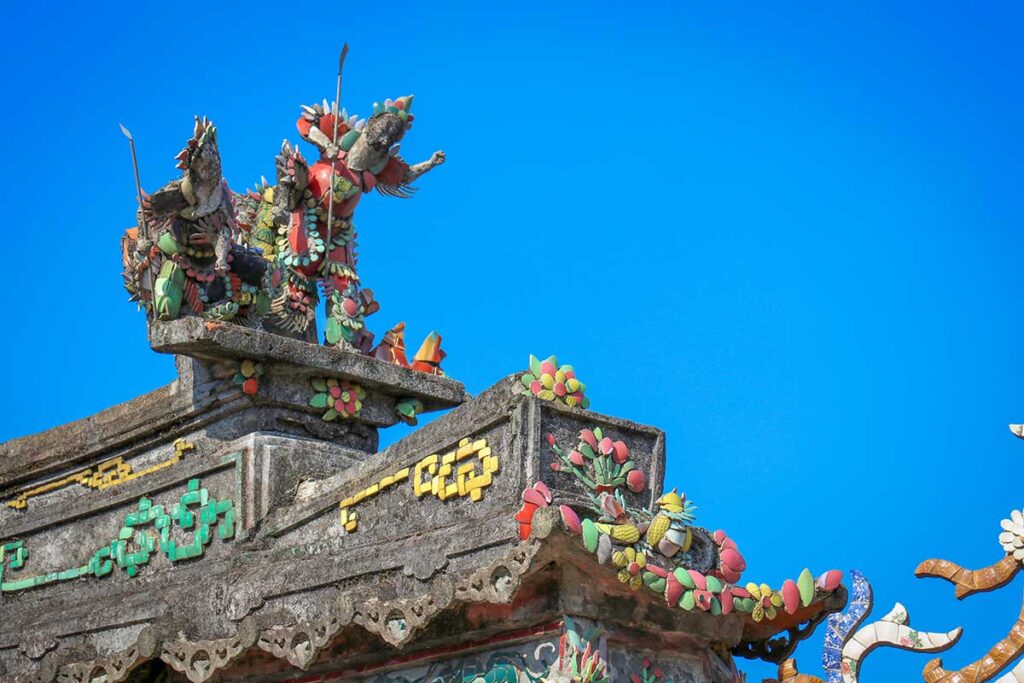
Throughout the complex, look for dragons, phoenixes, turtles, and unicorns, each symbolizing strength, harmony, or protection. The roof ridges and door frames are decorated with porcelain mosaics in vibrant reds, greens, and golds. This attention to detail reflects the importance of feng shui, visual harmony, and balance in every element of the architecture.
6. Festivals & Rituals
The hall hosts several important traditional festivals, including the Lantern Festival, the Luc Tanh Ceremony for six revered generals, and the Mazu Festival (March 23 lunar calendar). During these events, the hall fills with locals offering incense, praying, and participating in cultural performances — a great time to witness the spiritual life of Hoi An’s Chinese community.
Location & visiting information
Opening times
The Fujian Assembly Hall (Phuc Kien) is typically open daily from 8:00 AM to 5:00 PM. These are standard hours for most sites in Hoi An’s Ancient Town, but check locally for any changes during festivals or holidays.
Entrance fee
The hall is included as part of the Hoi An Ancient Town ticket system.
- Entry ticket: 120,000 VND, valid for 24 hours, includes access to 5 sites: 3 of your choice (like assembly halls or museums) and 2 from a fixed list (e.g. Japanese Bridge, Quan Cong Temple).
- If you want to visit more than 3 assembly halls, you’ll need to buy an extra ticket.
Tip: Plan your ticketed sites in advance. The Fujian Assembly Hall is the most popular among the Chinese halls and a strong candidate for your list.
Where is it?
The hall is located at 46 Tran Phu Street, right in the heart of Hoi An Ancient Town. It’s just a few minutes’ walk east of the Japanese Covered Bridge, and close to the Museum of Folk Culture and other landmarks along Tran Phu.
How to get there
If you’re already in the Ancient Town, it’s easiest to walk. The Tran Phu walking route is a linear path passing several major sights, including the Cantonese Assembly Hall, Phuc Kien, and Hai Nam. You can explore them all in sequence.
If coming from outside the Old Town:
- Taxi or Grab: Ask for drop-off near one of the main Ancient Town entrances.
- Bike: Park outside the walking zone (bike parking near the Central Market is convenient).
- On foot: Most hotels near the Old Town are within walking distance.
Tips for visiting
- Go Early
Visit before 9:00 AM to enjoy the peaceful atmosphere and avoid the tour groups and mid-day heat. - Look Closely at the Details
The hall is full of symbolic carvings, altars, and Chinese calligraphy. Slow down to spot the dragons, phoenixes, and miniature scenes hidden in the rooflines and mosaics. - Respect the Sacred Spaces
Some inner areas have no photography signs. Be discreet and avoid using flash inside the main shrine. - Dress Modestly
Shoulders and knees covered is a good rule. This helps show respect and is appreciated by temple caretakers. - Plan a Walking Route
Combine your visit with the Cantonese Assembly Hall (west of the Japanese Bridge) and the Hai Nam Assembly Hall (east along Tran Phu). It’s an easy self-guided circuit.
Is it worth visiting?
Yes — this is the most iconic assembly hall in Hoi An.
The Fujian Assembly Hall (Phuc Kien) stands out for its size, detail, and atmosphere. It’s more crowded than some of the other halls, but also more visually impressive. If you’re into architecture, Chinese culture, or just want great photos, don’t miss it.
Even if you’re not usually into temples, this one feels special.
If you only visit one assembly hall in Hoi An, make it this one.
Other Assembly Halls in Hoi An
Hoi An is home to five historic Chinese assembly halls, each built by a different regional Chinese community. If you’re exploring deeper into Hoi An’s cultural roots, these are well worth including:
- Cantonese Assembly Hall – Located near the Japanese Bridge, this hall is dedicated to Quan Cong, a symbol of loyalty and bravery. Impressive wood-carvings and lively festival atmosphere.
- Hai Nam Assembly Hall – Built to honor 108 Hainanese merchants who were wrongfully executed. Peaceful courtyard, meaningful story, and less crowded than others.
- Teochew Assembly Hall – Smaller but beautifully preserved. Known for its ornate roof details and devotion to deities protecting sailors.
- Trung Hoa Assembly Hall (Ngu Bang) – The only one open for free. A shared hall for Chinese from five regions, with a striking blue color and educational displays.
Each hall reflects the unique identity of its community and adds another layer to Hoi An’s multicultural heritage.
You can visit up to three of them with your Ancient Town ticket, so choose based on your interests and route.
